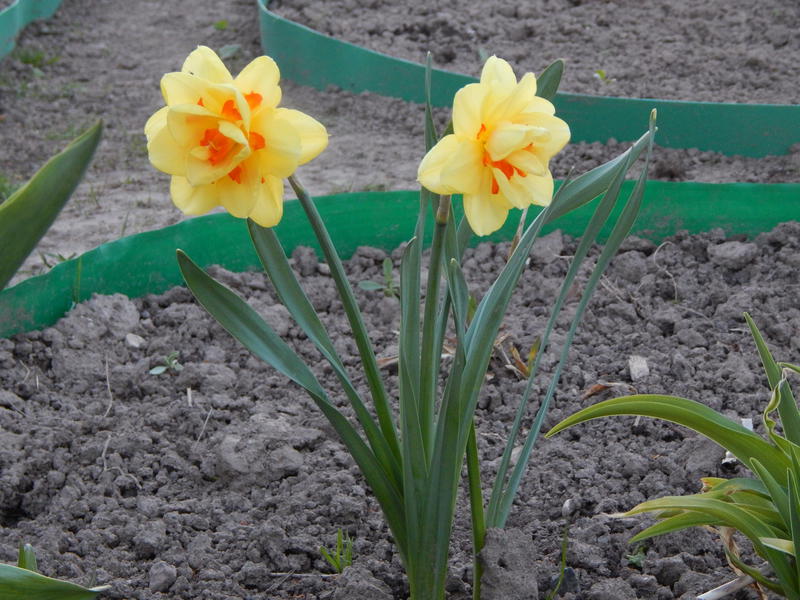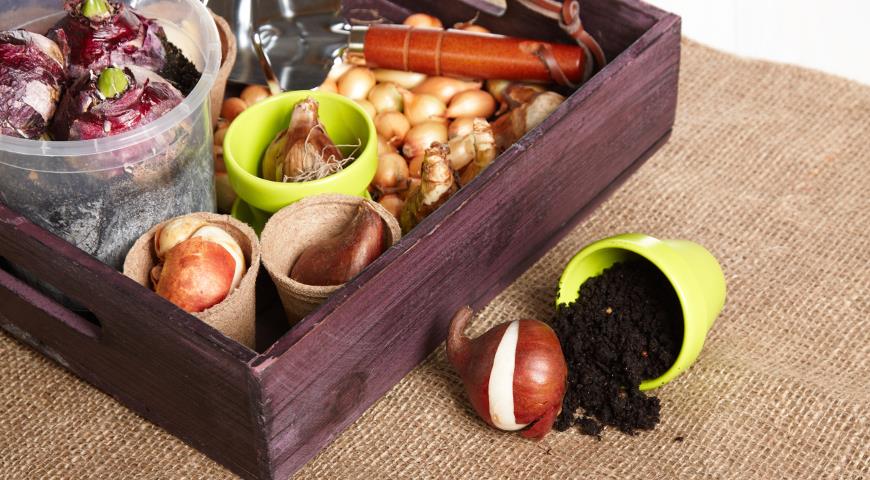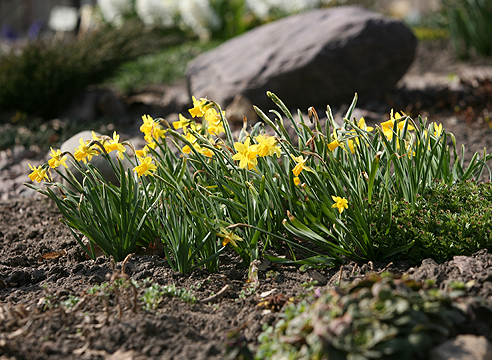Daffodils can be planted not only in summer and spring, but also in autumn. This planting has a number of advantages, and in spring the daffodils will bloom several weeks earlier than usual. When planting bulbs in autumn, the recommendations of experienced gardeners will tell about the timing of planting in the regions.
Content
Benefits of Autumn Planting
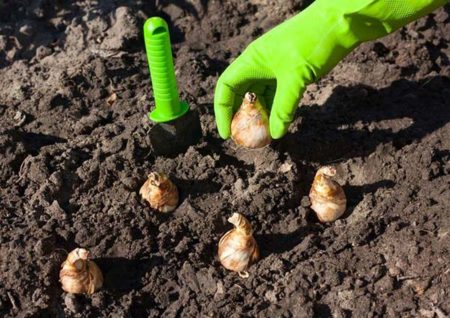 The life cycle of flowers has a short rest period, so it is better to plant them before the roots begin to grow actively. If the flowers are planted on the right time, then the bulb has time to grow strong roots, and then the plant survives the winter well. During the winter, the flower gains strength for rapid growth in the spring. In addition, bulbs during autumn planting do not need to be placed for several days in the cold, such as during spring. Over the winter, planting material gains stable immunity, subsequently does not get sick, and flowering itself lasts longer.
The life cycle of flowers has a short rest period, so it is better to plant them before the roots begin to grow actively. If the flowers are planted on the right time, then the bulb has time to grow strong roots, and then the plant survives the winter well. During the winter, the flower gains strength for rapid growth in the spring. In addition, bulbs during autumn planting do not need to be placed for several days in the cold, such as during spring. Over the winter, planting material gains stable immunity, subsequently does not get sick, and flowering itself lasts longer.
Dates of planting daffodils
The term for planting daffodils in the fall depends on the specific region. The climate in each area has features, so the period will vary. For regions with harsh climatic conditions, the period shifts earlier by a couple of weeks than for the central part. How to plant daffodils in the fall will help to understand the breakdown by region.
For Moscow region
For the Moscow Region, a favorable time for planting bulbs is considered to be the period from August 15 to September 15. The temperature of the earth should not be lower than 8 degrees Celsius, and the surrounding temperature, especially at night, will decrease markedly. Specific date when to plant daffodils in the fall in the suburbs, no, be guided by the temperature of the earth. Before the first frosts, the bulbs need to be planted, they must have time to let out the roots.
For the Leningrad region
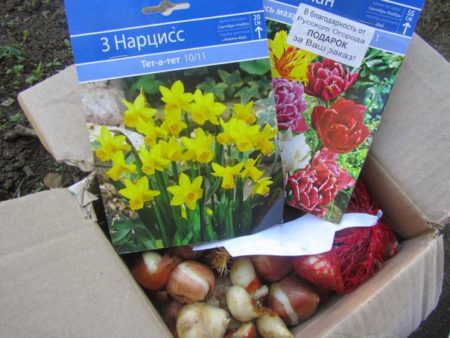 The dates for planting daffodils for the Leningrad Region coincide with the dates for the Moscow Region, so you can safely plant daffodils from mid-August to mid-September. If the region expects bad weather conditions, a sudden cold snap, then accelerate with landing.
The dates for planting daffodils for the Leningrad Region coincide with the dates for the Moscow Region, so you can safely plant daffodils from mid-August to mid-September. If the region expects bad weather conditions, a sudden cold snap, then accelerate with landing.
For the Urals
In the Urals, autumn begins earlier than in the central part, and therefore landing here takes place 2 weeks earlier. You can plant daffodils from August to September. Look at the weather forecast for the next 2 weeks and choose the best day for planting bulbs in the fall in the ground.
For Siberia
In Siberia, daffodils are planted in August, preferably on the 10th of the month. If weather conditions no longer allow, the temperature of the earth has dropped to almost zero, then it’s better to refrain from planting - the earth has already stopped, and the bulbs in it will not take root.
Landing under the winter
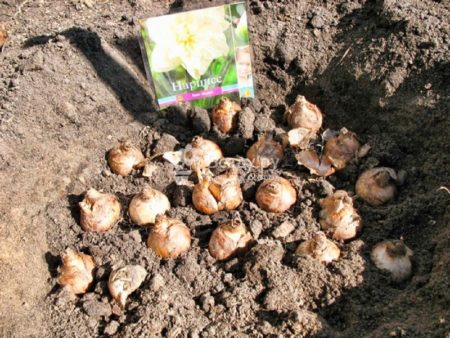 If you are going to plant daffodils in the winter, you have made the right decision. Now the main task is to determine the correct seat, prepare the soil in advance and comply with the planting technology. With the right actions in early spring, you will admire the first shoots of bright colors.
If you are going to plant daffodils in the winter, you have made the right decision. Now the main task is to determine the correct seat, prepare the soil in advance and comply with the planting technology. With the right actions in early spring, you will admire the first shoots of bright colors.
Seat selection
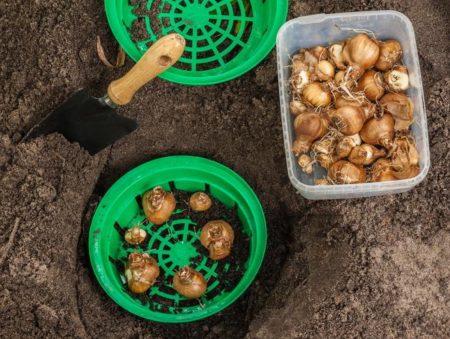 Flowers do not like wind gusts, so choose a place protected from the wind.Place the flowerbed on a slight slope from the side where the cold wind blows. Direct sunlight should be avoided, the most suitable option is light partial shade. There are bright varieties of daffodils (pink, orange), which with prolonged exposure to the sun burn out, fade. Therefore, place such varieties in the shade of the crowns of trees along the fences. Daffodils grow well next to other shrubs and trees: birch, mountain ash, linden, sea buckthorn. A tree should not cast too much shadow so that the flowers will have enough light and heat from the sun.
Flowers do not like wind gusts, so choose a place protected from the wind.Place the flowerbed on a slight slope from the side where the cold wind blows. Direct sunlight should be avoided, the most suitable option is light partial shade. There are bright varieties of daffodils (pink, orange), which with prolonged exposure to the sun burn out, fade. Therefore, place such varieties in the shade of the crowns of trees along the fences. Daffodils grow well next to other shrubs and trees: birch, mountain ash, linden, sea buckthorn. A tree should not cast too much shadow so that the flowers will have enough light and heat from the sun.
The soil
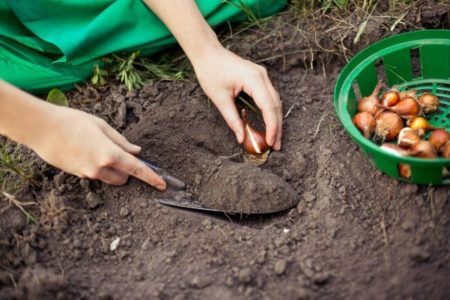 Land for flowers can not be prepared in advance, as the plants are considered unpretentious and grow in almost any soil. However, if the soil is nutritious, then the appearance of the flower becomes much more attractive: the petals have a beautiful saturated color, the inflorescence itself is larger in size, and the flowering time significantly increases.
Land for flowers can not be prepared in advance, as the plants are considered unpretentious and grow in almost any soil. However, if the soil is nutritious, then the appearance of the flower becomes much more attractive: the petals have a beautiful saturated color, the inflorescence itself is larger in size, and the flowering time significantly increases.
The soil for daffodils should be:
- porous;
- loamy;
- acidified.
Approximately 3 months before planting, add 1 square meter in a glass of ash. Ash can be replaced with superphosphate. Then dig the soil. When digging, remove extraneous grass and weeds from the ground. You need to dig up to a depth of no more than 30 cm. If you have humus, mineral fertilizers, and the soil on the site itself is poor, then add nutrients to it.
Sandy soil should be mixed with clay so that it does not freeze in winter. Since sand freezes much better than clay soil, bulbs can die from the cold during the winter. Add 1 bucket of humus or clay to 1 square meter of sandy soil. Too clay soil is also undesirable for breeding flowers. Dilute it with sand or peat.
How to plant daffodils in autumn
Sort the flower bulbs a few days before planting. Remove rotted, spoiled tubers immediately, they will not be needed. Remove the top 2-3 layers of husk from the bulbs. Soak the planting material for 20-30 minutes in a weak solution of potassium permanganate for disinfection. Be sure to dry the bulbs before planting them in the ground.
The day before planting in the ground where the bed is planned, make:
- tbsp ammonium nitrate;
- 1.5 tbsp superphosphate;
- 2 tbsp potassium sulfate.
After adding fertilizer, again dig the soil, level it with a rake and fill the holes for planting the bulbs.
The depth of planting of the tuber should be approximately 2.5-3 times greater than its height. For large varieties, make a depth of about 15-20 cm, and for small and medium ones - no more than 15 centimeters. When planting in rows, leave a distance between small varieties of 5-10 cm, and large bulbs should be planted at least 15 cm apart from each other.
Features of watering
Immediately after planting, pour the soil from the watering can with cool water. As soon as water is absorbed into the soil, mulch the flowerbed with rotted humus. Mulch will protect the bulbs and the earth from dehydration. When watering, the water flow should be at least 2-3 liters per 1 square meter of soil. Immediately after watering with hands or a rake, loosen the soil so that an impenetrable crust does not form on the ground.
Container landing
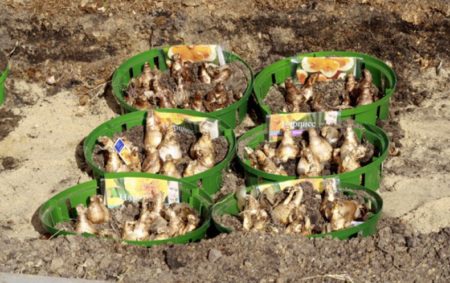 Tubers can not only be planted in open ground, but also grown at home in containers. Take a pot with a diameter of 10-13 cm, make several holes in the bottom so that the water can drain. Planting daffodils in containers is carried out in the following way:
Tubers can not only be planted in open ground, but also grown at home in containers. Take a pot with a diameter of 10-13 cm, make several holes in the bottom so that the water can drain. Planting daffodils in containers is carried out in the following way:
- a drainage layer 5-6 cm high is laid at the bottom of the pot, and fertile soil is laid on top of it;
- the tubers are laid on the ground and pressed. One pot includes 3-4 plants;
- clean the pot of tubers in a cool dark place with a temperature of 5-8 degrees and leave the bulbs to germinate for 3 months. Watering plants need 2 times a month;
- after 3 months, the containers with daffodils are placed in a bright warm room. Watering is increased to 1 time per week, you can feed the flowers with nitrogen-potassium fertilizers. Soon daffodils bloom. The flowering period can be extended by moving the plants to a cooler room.
You can plant and grow flowers in a container in different ways: at the beginning of winter, at the end of summer. About 2.5-3 months pass from the moment of planting to blooming.
Further care
Right after landing fertilize prohibited. Growth stimulants cannot be used either, since the bulb will begin to sprout too soon and then freeze. If you planted fertilizers in the soil during planting, then they will be enough even until spring or even next fall.
Excess moisture adversely affects the bulbous type of flowers, so with constant cold rains cover the garden bed with foil. The film will prevent waterlogging of the earth. Whenever possible, try to loosen the soil at least once a week so that fresh air penetrates the soil, because the tubers need it.
Winter preparations
 Daffodils, although they have good frost resistance, but require shelter for the winter. Before severe frosts occur on the flower bed, lay a layer of mulch. As a mulch, a rotted humus, peat, sawdust, straw, leaves are suitable. The harsher and earlier the winter comes to the region, the thicker the layer of mulch will be. For Siberia and the Urals, immediately before the cold weather, cover the flower bed with spanbond or lutrasil. Do not cover the plants with a film, it prevents air from entering, a greenhouse effect forms under it over time: the bulb simply decays in the ground. If in your area the temperature in winter does not drop below - 20 degrees, then ordinary snow will shelter flowers in the ground from frost. Cover the flowerbed with special material is necessary only for regions with a harsh climate.
Daffodils, although they have good frost resistance, but require shelter for the winter. Before severe frosts occur on the flower bed, lay a layer of mulch. As a mulch, a rotted humus, peat, sawdust, straw, leaves are suitable. The harsher and earlier the winter comes to the region, the thicker the layer of mulch will be. For Siberia and the Urals, immediately before the cold weather, cover the flower bed with spanbond or lutrasil. Do not cover the plants with a film, it prevents air from entering, a greenhouse effect forms under it over time: the bulb simply decays in the ground. If in your area the temperature in winter does not drop below - 20 degrees, then ordinary snow will shelter flowers in the ground from frost. Cover the flowerbed with special material is necessary only for regions with a harsh climate.
Useful Tips
If you are growing flowers for the first time, then adopt a few simple but practical tips. They will help to avoid mistakes in growing and will help in creating a beautiful flowerbed:
- in one place the flowers are able to grow no longer than 5 years, then they need to be replanted;
- for good flowering, feed plants with a potassium supplement 1-2 times a season;
- with late planting, you need to mulch the soil with peat;
- To understand when to plant daffodil bulbs in autumn, measure the temperature of the earth. If it is 8-10 degrees, then plant the bulbs:
- when the bulbs bloom, they need to be dug up for storage. Wait until all leaves on the stem turn yellow.
Often with daffodils tulips are planted under the winter. When planting tulips and daffodils in the fall, it will help determine the night temperature. If the thermometer goes down to zero, then you can plant the bulbs in the ground.
Transfer to another place
 When it takes 4-5 years from the moment of planting, the tubers need to be transplanted to a new place. This is necessary to update the planting material, as flowering is lost with age, and the inflorescences themselves become small and faded. It is worth replanting flowers if the flowerbed is too large and takes up a lot of space on the site.
When it takes 4-5 years from the moment of planting, the tubers need to be transplanted to a new place. This is necessary to update the planting material, as flowering is lost with age, and the inflorescences themselves become small and faded. It is worth replanting flowers if the flowerbed is too large and takes up a lot of space on the site.
Choose the time when the daffodil bushes begin to exfoliate, dig the bulbs with a fork. Cut the stem and dry leaves from the plant, put the bulb to dry in a dark and dry place. Remove the earth from the dry tuber, separate the small “children” and soak the planting material in a weak solution of potassium permanganate. Then dry the tubers well from moisture.
The flowers are transplanted from August to October, and you can dig up the tubers in early or mid-summer, while they rest.
How to store before planting in the fall
 Remove the dug tubers from the earth, process in a fungicidal solution and dry. Put the tubers in a wooden box and place it in the canopy, on the veranda, in the basement. You can not store planting material in a room where there is no ventilation. During storage, plants release harmful gas, which has a bad effect on plants and causes their death. You can arrange the tubers in shelves, but only in one layer. When laying in 2-3 layers, lay the distance between the tubers with paper so that they do not touch each other.
Remove the dug tubers from the earth, process in a fungicidal solution and dry. Put the tubers in a wooden box and place it in the canopy, on the veranda, in the basement. You can not store planting material in a room where there is no ventilation. During storage, plants release harmful gas, which has a bad effect on plants and causes their death. You can arrange the tubers in shelves, but only in one layer. When laying in 2-3 layers, lay the distance between the tubers with paper so that they do not touch each other.
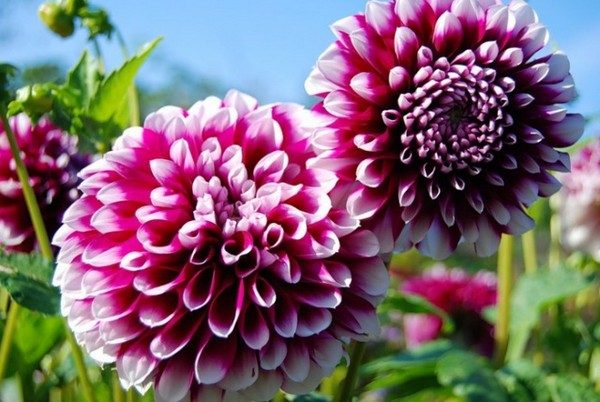 You may be interested in:
You may be interested in:Once every 10-14 days, check how the bulbs are stored. On the skin should not be visible damage, places of decay. Healthy tubers are odorless and firm to the touch.
In spring, daffodils will become the main decoration of the garden and will attract a lot of enthusiastic looks. You can grow flowers both for beginners and experienced gardeners, there are no difficulties with them. Healthy plants require minimal care, so they have gained great popularity among gardeners.

